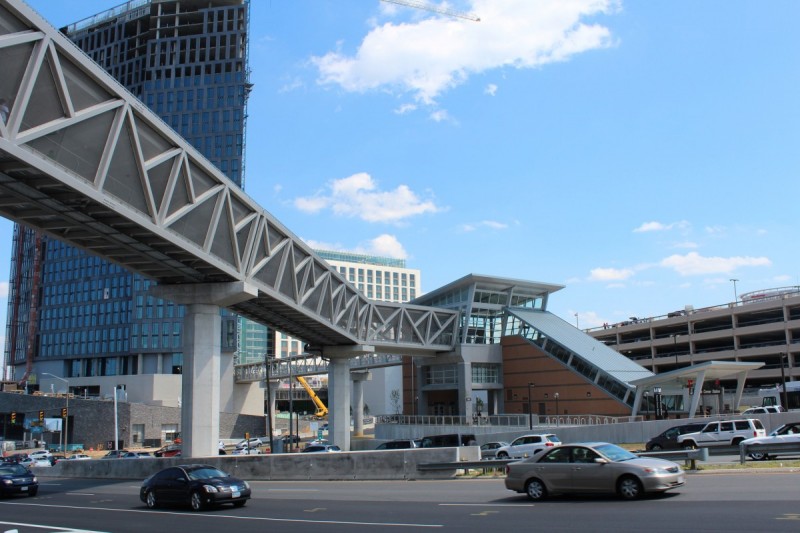Don’t want to venture outdoors? Take cover in one of these indoor shortcuts.

International Square's color scheme even harmonizes with the Metro. Image by the author.
Stepping off Metro and want to avoid chilly winter winds — or scorching summer humidity — for a few more moments? There might be an indoor shortcut along your route that could shave some distance off your walk, or at least let you enjoy a few moments of extra climate-control en route.
For instance, lately I've been looking forward to visiting what one Yelp reviewer called “the most overpriced and underwhelming food court in the DC area,” International Square. It's attached to the west entrance of Farragut West station, and between 6 AM and 6 PM it offers a diagonal through-block shortcut between the station entrance at 18th and Eye and the southeast corner of 19th and K.
A few large buildings around Chinatown span what were street right of ways where pedestrians are still allowed to walk through. Between F and G streets, 8th Street continues through the Reynolds Center for American Art and Portraiture (better known for its tenant, the Portrait Gallery), and 4th Street continues through the National Building Museum.
The National Portait Gallery. Image by Wilsonious licensed under Creative Commons.
G Street between 6th and 7th is interrupted by the Verizon Center, but pedestrians can skirt the arena to the north via an alley, a walkway, and the Gallery Place building's atrium.
In more suburban areas, enclosed walkways sometimes connect pedestrians to transit stations to avoid what would otherwise be pedestrian-hostile roads. For instance, the north entrance of the Friendship Heights Metro station has exits onto four corners of the intersection between Wisconsin & Western Avenues. The stairs allow someone to visit four major shopping centers above the station entrance (in both DC and Maryland) without crossing either seven-lane Wisconsin or five-lane Western Avenue.
Similarly, two pedestrian bridges span the busy roads surrounding the Tysons Corner Center shopping mall; these make it possible to walk from the Metro station to the Towers Crescent office buildings (popularly known as “the shopping bag buildings”) in 12 minutes.
The bridge at Tysons. Image by Matt’ Johnson licensed under Creative Commons.
GGWash contributors shared a few other suggestions. David Meni suggested that one could use Metro's new grace period policy to walk through any Metro station that has multiple entrances. For instance, many people use the Anacostia Metro station as a de facto pedestrian tunnel under I-295.
Travis Maiers and Maxime Devilliers suggested walking through the X-shaped L'Enfant Plaza station and two buildings attached to it — the L'Enfant Plaza shopping concourse, which extends west from the western end of the station, and the Capital Gallery building that extends east from the station's north entrance, from 7th east to 6th and C. Travis points out that the combination could cut four blocks off the walk from the Air and Space Museum to the Maine Avenue fish market.
Maxime also notes that both the Grand Hyatt hotel and Macy's are connected to the Metro Center station. Using these two passages, as well as the Red Line platform, could get someone from 10th and H Streets NW to the corner of 13th and G entirely indoors.
Union Station's indoor concourse extends the width of a city block, and some adjacent buildings have connected into it. Alex Cox uses the Station Place office building (home to the Securities & Exchange Commission and Kaiser Permanente) as de facto east entrance to Union Station; it has an indoor connection to the east end of the Amtrak concourse.
In Arlington, Canaan Merchant points to the walkways to and through the former Ballston Common mall. Crystal City also has a well-known system of underground walkways.
Image by inazakira licensed under Creative Commons.
Although indoor pedestrian walkways can be convenient, they work best in dense cities when they can supplement, rather than supplant, busy sidewalks. In other cities, from Toronto to Hong Kong to Minneapolis, extensive pedestrian networks span dozens or even hundreds of downtown blocks — a phenomenon that many observers in those cities say has dampened streets' liveliness, heightened segregation, and deprived the public realm.
Given the comparatively low pedestrian densities in DC relative to, say, Hong Kong, it's probably best that the DC comprehensive plan discourages parallel links. But, as long as we have them, we might as well use them.
What other shortcuts do you use to make your walks around greater DC shorter or more pleasant?
We first published this post in March 2017.
